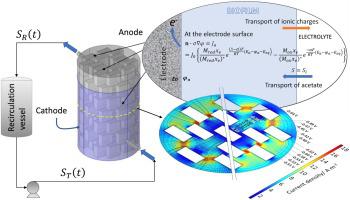当前位置:
X-MOL 学术
›
Biochem. Eng. J.
›
论文详情
Our official English website, www.x-mol.net, welcomes your
feedback! (Note: you will need to create a separate account there.)
Modeling 3D current and potential distribution in a microbial electrolysis cell with augmented anode surface and non-ideal flow pattern
Biochemical Engineering Journal ( IF 3.7 ) Pub Date : 2020-10-01 , DOI: 10.1016/j.bej.2020.107714 Karla M. Hernández-García , Bibiana Cercado , Francisca A. Rodríguez , Fernando F. Rivera , Eligio P. Rivero
Biochemical Engineering Journal ( IF 3.7 ) Pub Date : 2020-10-01 , DOI: 10.1016/j.bej.2020.107714 Karla M. Hernández-García , Bibiana Cercado , Francisca A. Rodríguez , Fernando F. Rivera , Eligio P. Rivero

|
Abstract The extraction of energy from wastewater organic matter by microbial electrolysis cells (MEC) is a promising idea. However, different challenges have to be overcome before this technology can be used in a practical application. One of the most important is the development of reactor configurations that can be able to produce higher external current and, thereby, a larger amount of energy carriers without significant deterioration of cell performance. Thus, a comprehensive 3D model, developed in this work, aims to investigate distributions of current, potential, and concentrations inside a MEC reactor and their effect on overpotential distribution over the surface of electrodes to evaluate the reactor performance. The model is applied to simulate a flow reactor designed with 147.6 m2 m−3 geometric surface area of the anode per unit volume. The results show the combined effect of flow pattern and electric field on the reactor behavior and performance. The model results of integrated current density over electrode surfaces closely describe experimental data of external current and hydrogen generation vs. time in feeding cycles. Experimental averages of maximum hydrogen production rate and electric current reached in each feeding cycle were 0.107 m3 m−3 h-1 and 0.29 A, respectively.
中文翻译:

模拟具有增强阳极表面和非理想流动模式的微生物电解槽中的 3D 电流和电位分布
摘要 通过微生物电解池(MEC)从废水有机物中提取能量是一个很有前景的想法。然而,在将该技术用于实际应用之前,必须克服不同的挑战。最重要的一项是开发能够产生更高外部电流的反应器配置,从而产生更多的能量载体,而不会显着降低电池性能。因此,在这项工作中开发的综合 3D 模型旨在研究 MEC 反应器内电流、电位和浓度的分布及其对电极表面过电位分布的影响,以评估反应器性能。该模型用于模拟设计为每单位体积阳极几何表面积为 147.6 m2 m-3 的流动反应器。结果表明流型和电场对反应器行为和性能的综合影响。电极表面上积分电流密度的模型结果紧密地描述了外部电流和氢气生成与进料循环中时间的关系的实验数据。每个进料循环中达到的最大产氢速率和电流的实验平均值分别为 0.107 m3 m-3 h-1 和 0.29 A。
更新日期:2020-10-01
中文翻译:

模拟具有增强阳极表面和非理想流动模式的微生物电解槽中的 3D 电流和电位分布
摘要 通过微生物电解池(MEC)从废水有机物中提取能量是一个很有前景的想法。然而,在将该技术用于实际应用之前,必须克服不同的挑战。最重要的一项是开发能够产生更高外部电流的反应器配置,从而产生更多的能量载体,而不会显着降低电池性能。因此,在这项工作中开发的综合 3D 模型旨在研究 MEC 反应器内电流、电位和浓度的分布及其对电极表面过电位分布的影响,以评估反应器性能。该模型用于模拟设计为每单位体积阳极几何表面积为 147.6 m2 m-3 的流动反应器。结果表明流型和电场对反应器行为和性能的综合影响。电极表面上积分电流密度的模型结果紧密地描述了外部电流和氢气生成与进料循环中时间的关系的实验数据。每个进料循环中达到的最大产氢速率和电流的实验平均值分别为 0.107 m3 m-3 h-1 和 0.29 A。











































 京公网安备 11010802027423号
京公网安备 11010802027423号